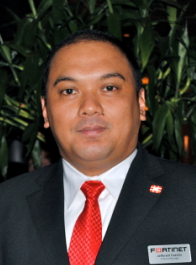Customers of Fortinet may now “quickly and easily configure their FortiGate appliances” based on their unique business and security requirements. The new capability is made possible with the new FortiOS 5 operating system, which serves as the foundation for the company’s FortiGate network security platform.
With one click, customers can choose from a variety of security configuration options, including: High Speed Firewall, NGFW, ATP, Web Filtering, UTM and others, according to the company.
Available now as a free update to all existing customers with a valid support contract, FortiOS 5 also gives organizations real-time and historical insight on network use based on application, user and device.
For Advanced Threat Protection (ATP), FortiOS 5 is packed with enhanced security tools combat multi-vector persistent attacks
“In order to increase protection, simplify management and reduce costs, enterprises today are migrating away from multi-vendor firewall environments in favor of a single-vendor model,” said Jeff Castillo, Country Managing Director of Fortinet Philippines. “For example, an enterprise may have high-performance firewalls for its datacenters, NGFWs for their campus perimeters and UTMs for their distributed offices. With its singular focus on innovating security and security-focused R&D, Fortinet provides a network security platform with a wide array of robust security functionality for datacenters, campus perimeter and distributed offices.”
With Fortinet Feature Select, enterprises can quickly and easily configure their FortiGate appliances based on their unique business and security requirements. These preset configurations can be done with a single button click at the time of system setup or at any time during the system’s deployment.
Configuration options include NGFW (includes Firewall, intrusion prevention and application control); ATP (includes advanced threat protection and endpoint control); WF (includes Web filtering and explicit proxy); NGFW + ATA (includes NGFW and ATP features) and UTM (includes all previously mentioned features plus email filtering, data loss prevention, vulnerability scanning).
Better Protection with Better Visibility
The new Contextual Visibility feature in FortiOS 5 gives administrators deeper insights into historic or real-time network activities using detailed analytics. The types of data that can be extracted include IP and Port, geographical IP, session type, user names, network usage, network coverage and the types of applications and devices that are connecting to the network. With this, administrators can use correlated data to identify top clients associated with particular threats and further isolate suspicious Websites and IP addresses.
Protection Against Advanced Targeted Attacks (ATA)
ATAs, also referred to as Advanced Persistent Threats (APTs), target specific organizations, infiltrate from multiple vectors and can remain stealthy for an undetermined amount of time before exfiltrating data. The new FortiGuard Advanced Threat Protection Service offers a multi-pronged approach to security that helps protect against attacks that could arrive via zero day vulnerability, undiscovered malware, phishing emails and/or password hacks. The features within the ATP service include botnet blacklisting, antimalware signatures and cloud-based sandboxing.
Securing BYOD Environments
Other features of FortiOS 5 are the user identification and its capacity to secure mobile devices and BYOD (bring-your-own-device) environments. According to Castillo, each employee in a company has a unique user account or access to their network which means that he can automatically access their internal network to get whatever information he needs even when he is out of the office.
In a BYOD environment, FortiOS 5 can identify devices and apply security policies. “You can have your own access. You can use the device even if it’s not company-owned provided it has security policies,” Castillo said.
Made Also for SMBs
The features and capabilities of FortiOS 5 are not only limited to large enterprises’ usage. They also help small and medium businesses (SMBs) be better protected against advanced threats and manage their networks.
“We have a very broad product portfolio that stands for small business, major business, large enterprise to service providers. These functionalities are 97% uniform across these product portfolio which means that whatever functionality the telcos can enjoy can also be enjoyed by small businesses,” shares Napoleon Castillo, Senior Consultant of Fortinet Philippines.
Next-Generation Firewalls
According to Castillo, Fortinet has four models that are being categorized as NGFW. These are FG-1000C, FG-3240C, FG-3600C and FG-3950C.
“Each model has specific specifications that will cater for each company based on their requirements. These specs include the features and capacities, what it can cover and how big the network is,” he said.
Castillo also added that organizations which are still using the traditional firewall can migrate to the next generation firewall without any risks involved. “It will just make their network more secure,” he said.













































































































